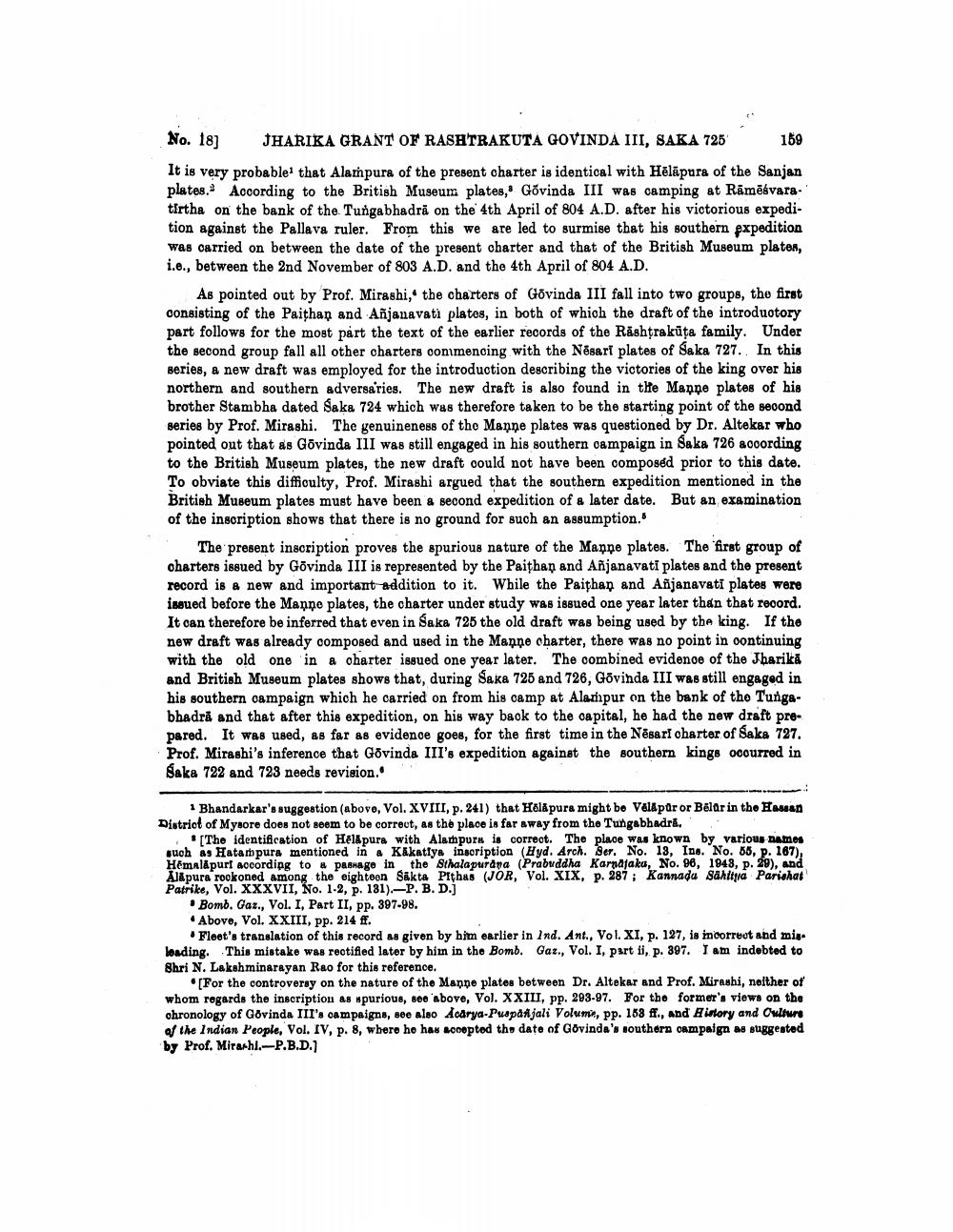________________
No. 18]
JHARIKA GRANT OF RASHTRAKUTA GOVINDA III, SAKA 725
169
It is very probable that Alampura of the present charter is identical with Hēlāpura of the Sanjan plates. According to the British Museum plates, Govinda III was camping at Rāmēsvara. tirtha on the bank of the Tungabhadra on the 4th April of 804 A.D. after his victorious expedition against the Pallava ruler. From this we are led to surmise that his southern expedition was carried on between the date of the present charter and that of the British Museum platen, i.e., between the 2nd November of 803 A.D. and the 4th April of 804 A.D.
As pointed out by Prof. Mirashi, the charters of Govinda III fall into two groups, the first consisting of the Paithan and Añjanavati plates, in both of which the draft of the introduotory part follows for the most part the text of the earlier records of the Răshtrakūţa family. Under the second group fall all other charters oommencing with the Nēsari plates of Saka 727. In this series, a new draft was employed for the introduction describing the victories of the king over his northern and southern adversaries. The new draft is also found in the Manne plates of his brother Stambha dated Saka 724 which was therefore taken to be the starting point of the second series by Prof. Mirashi. The genuineness of the Manne plates was questioned by Dr. Alteker who pointed out that as Govinda III was still engaged in his southern campaign in Saka 726 according to the British Museum plates, the new draft could not have been composed prior to this date. To obviate this difficulty, Prof. Mirashi argued that the southern expedition mentioned in the British Museum plates must have been a second expedition of a later date. But an examination of the inscription shows that there is no ground for such an assumption.
The present inscription proves the spurious nature of the Manne plates. The first group of charters issued by Govinda III is represented by the Paithan and Añjanavati plates and the present record is a new and important addition to it. While the Paithan and Añjanavati plates were issued before the Manne plates, the charter under study was issued one year later than that record. It can therefore be inferred that even in Saka 725 the old draft was being used by the king. If the new draft was already composed and used in the Manne charter, there was no point in oontinuing with the old one in a charter issued one year later. The combined evidenoe of the Jharika and British Museum plates shows that, during Saka 725 and 726, Govinda III was still engaged in his southern campaign which he carried on from his camp at Alampur on the bank of the Tungabhadra and that after this expedition, on his way back to the capital, he had the new draft prepared. It was used, as far as evidence goes, for the first time in the Nēgari charter of Saka 727. Prof. Mirashi's inference that Govinda III's expedition against the southern kings ocourred in Saka 722 and 723 needs revision.
1 Bhandarkar's suggestion (above, Vol. XVIII, p. 241) that Holapura might be Velapúr or Beldr in the Hassan District of Mysore does not seem to be correct, as the place is far away from the Tungabhadra.
*[The identification of Hel&pura with Alampura is correct. The place was known by various names such as Hatampura mentioned in a Kakatiya inscription (Hyd. Arch. Ser. No. 13, Ine. No. 08, P. 167), Himalapurt according to #pannage in the Sthalapurana (Prabuddha Karnataka, No. 96, 1948, p. 29), and Aldpura rookoned among the eightoon Sakta Pithas (JOR, Vol. XIX, p. 287: Kannada sahitya Parishat Patrike, Vol. XXXVII, No. 1-2, p. 181).-P. B. D.]
• Bomb. Gaz., Vol. I, Part II, pp. 397-98. * Above, Vol. XXIII, pp. 214 ff.
Fleet's translation of this record as given by him earlier in Ind. Ant., Vol. XI, p. 127, is incorrect and mig. loading. This mistake was reotified later by him in the Bomb. Gaz., Vol. I, part 1, p. 397. I am indebted to Shri N. Lakshminarayan Rao for this reference.
For the controversy on the nature of the Mappe plates between Dr. Altekar and Prof. Mirashi, neither of whom rogards the inscription as wpurious, 800 'above, Vol. XXIII, pp. 293-97. For the former's views on the chronology of Govinda III's campaigns, see also Acarya-Puspanjali Volume, pp. 168 f., and intory and Culture of the Indian People, Vol. IV, p. 8, where he has accepted the date of Govinda's southern campaign as suggested by Prof. Mirarhl.-P.B.D.)




